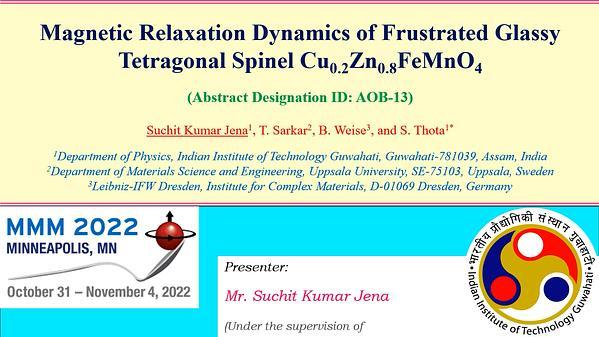Would you like to see your presentation here, made available to a global audience of researchers?
Add your own presentation or have us affordably record your next conference.
The structurally coupled interaction between a piezoelectric and ferromagnetic magnetostrictive material can be exploited to develop magnetoelectric systems which have potential to rival current technologies with reduced power consumption and size. In a magnetoelectric multiferroic system the bilateral control of the magnetic and piezoelectric response is dictated by the material properties, where a soft magnetic material with large magnetostriction facilitates the large voltage-induced strain in the piezo/ferroelectric layer. Thin film deposition techniques utilized for device fabrication often complicate the optimization of the interaction between layers due to inherent stresses occurring during deposition which are often deleterious to the magnetoelectric functionality. While incorporation of metalloid substitutions, such as in (Fe0.5Co0.5)1-xCx, and (Fe0.5Co0.5)1-xBx are able to reduce the inherent coercive field and retain a high magnetostrictive and piezomagnetic properties the as-deposited stress states are rarely discussed 1,2. To this end we have studied the incorporation of Hafnium in to an Fe50Co50 matrix with a focus on correlation between the film stress and magnetic properties. In these sputter-deposited thin films we find a relationship among the magnetic and stress properties as a function of doping percentage. With increasing Hf composition the system exhibits a minimum coercive field occurring at a crossover from a compressive to tensile stress state. Scanning electron microscopy (SEM) and X-ray diffraction (XRD) of the (Fe0.5Co0.5)1-xHfx system reveal the magnetic softening is also correlated to emergence of an amorphous phase with reduced grain size for these sputter-deposited films. This ternary alloy presents an additional avenue for optimization of artificial magnetoelectric systems and has applications for multiple types of microelectromechanical devices.
References:
1 J. Wang, Phys. Rev. Applied 12, 034011 (2019)
2 J. Lou, Appl. Phys. Lett. 91, 182504 (2007)
